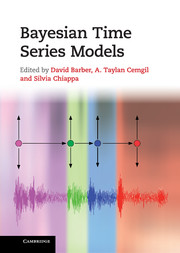Book contents
- Frontmatter
- Contents
- List of contributors
- Preface
- 1 Inference and estimation in probabilistic time series models
- I Monte Carlo
- II Deterministic approximations
- III Switching models
- IV Multi-object models
- V Nonparametric models
- 14 Markov chain Monte Carlo algorithms for Gaussian processes
- 15 Nonparametric hidden Markov models
- 16 Bayesian Gaussian process models for multi-sensor time series prediction
- VI Agent-based models
- Index
- Plate section
- References
15 - Nonparametric hidden Markov models
from V - Nonparametric models
Published online by Cambridge University Press: 07 September 2011
- Frontmatter
- Contents
- List of contributors
- Preface
- 1 Inference and estimation in probabilistic time series models
- I Monte Carlo
- II Deterministic approximations
- III Switching models
- IV Multi-object models
- V Nonparametric models
- 14 Markov chain Monte Carlo algorithms for Gaussian processes
- 15 Nonparametric hidden Markov models
- 16 Bayesian Gaussian process models for multi-sensor time series prediction
- VI Agent-based models
- Index
- Plate section
- References
Summary
Introduction
Hidden Markov models (HMMs) are a rich family of probabilistic time series models with a long and successful history of applications in natural language processing, speech recognition, computer vision, bioinformatics, and many other areas of engineering, statistics and computer science. A defining property of HMMs is that the time series is modelled in terms of a number of discrete hidden states. Usually, the number of such states is specified in advance by the modeller, but this limits the flexibility of HMMs. Recently, attention has turned to Bayesian methods which can automatically infer the number of states in an HMM from data. A particularly elegant and flexible approach is to assume a countable but unbounded number of hidden states; this is the nonparametric Bayesian approach to hidden Markov models first introduced by Beal et al. [4] and called the infinite HMM (iHMM). In this chapter, we review the literature on Bayesian inference in HMMs, focusing on nonparametric Bayesian models. We show the equivalence between the Polya urn interpretation of the infinite HMM and the hierarchical Dirichlet process interpretation of the iHMM in Teh et al. [35]. We describe efficient inference algorithms, including the beam sampler which uses dynamic programming. Finally, we illustrate how to use the iHMM on a simple sequence labelling task and discuss several extensions.
- Type
- Chapter
- Information
- Bayesian Time Series Models , pp. 317 - 340Publisher: Cambridge University PressPrint publication year: 2011
References
- 4
- Cited by



